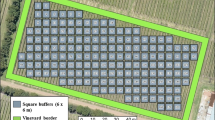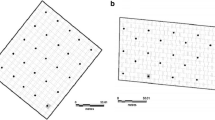Abstract
The goal of this study was to test the usefulness of high-spatial resolution information provided by airborne imagery and soil electrical properties to define plant water restriction zones within-vineyards. The main contribution of this is to propose a study on a large area representing the regions’ vineyard diversity (different age, different varieties and different soils) located in southern France (Languedoc-Roussillon region, France). Nine non-irrigated plots were selected for this work in 2006 and 2007. In each plot, different zones were defined using the high-spatial resolution (1 m2) information provided by airborne imagery (Normalised Difference Vegetation Index, NDVI). Within each zone, measurements were conducted to assess: (i) vine water status (Pre-dawn Leaf Water Potential, PLWP), (ii) vine vegetative expression (vine trunk circumference and canopy area), (iii) soil electrical resistivity and, (iv) harvest quantity and quality. Large differences were observed for vegetative expression, yield and plant water status between the individual NDVI-defined zones. Significant differences were also observed for soil resistivity and vine trunk circumference, suggesting the temporal stability of the zoning and its relevance to defining vine water status zones. The NDVI zoning could not be related to the observed differences in quality, thus showing the limitations in using this approach to assess grape quality under non-irrigated conditions. The paper concludes with the approach that is currently being considered: using NDVI zones (corresponding to plant water restriction zones) in association with soil electrical resistivity and plant water status measurements to provide an assessment of the spatial variability of grape production at harvest.




Similar content being viewed by others
References
Barbeau, G., Ramillon, D., Goulet, E., Blin, A., Marsault, J., & Landure, J. (2005). Effets combines de l’enherbement et du prote-greffe sur le comportement agronomique du Chenin [Combined effect of cover cropping and rootstock on agronomic behaviour of Chenin]. In H. R. Shultz (Ed.), Proceedings of 14th GESCO Congress (pp. 167–172). Geisenheim, Germany: Groupe d’Etudes des systèmes de Conduite de la Vigne.
Bramley R. G. V. (2001). Variation in the yield and quality of winegrapes and the effect of soil property variation in two contrasting Australian vineyards. In S. Blackmore & G. Grenier (Eds.), Proceeding of the 3rd European Conference on Precision Agriculture (pp. 767–772). France: Agro Montpellier, Ecole Nationale Superieure Agronomique de Montpellier.
Bramley, R. G. V. (2005). Understanding variability in winegrape production systems 2 Within vineyard variation in quality over several vintages. Australian Journal of Grape and Wine Research, 11, 33–45. doi:10.1111/j.1755-0238.2005.tb00277.x.
Corwin, D. L., & Lesch, S. M. (2005). Characterizing soil spatial variability with apparent soil electrical conductivity I. soil survey. Computers and Electronics in Agriculture, 46, 32–45.
Dry, P. R., & Loveys, B. R. (1998). Factors influencing grapevine vigour and the potential for control with partial rootzone drying. Australian Journal of Grape and Wine Research, 4, 140–148. doi:10.1111/j.1755-0238.1998.tb00143.x.
Fuentes, S., Conroy, J. P., Kelley, G., Rogers, G., & Collins M. (2005). Use of infrared thermography to assess spatial and temporal variability of stomatal conductance of grapevines under partial rootzone drying: An irrigation scheduling application. Acta Horticulture, 689, 309–316. (ISHS).
Ginestar, C., Eastham, J., Gray, S., & Lland, P. (1998). Use of sap flow sensor to schedule vineyard irrigation. I. Effect of post-verasion water deficit on water relations, vine growth, and yield of Shiraz grapevine. American Journal of Enology and Viticulture, 49, 413–420.
Girona, J., Mata, M., Del Campo, J., Arbone, A., Bartra, E., & Marsal, J. (2006). The use of midday leaf water potential for scheduling deficit irrigation in vineyards. Irrigation Science, 24, 115–117. doi:10.1007/s00271-005-0015-7.
Hall, A., Lamb, D. W., Holzapfel, B., & Louis, J. (2002). Optical remote sensing applications in viticulture––a review. Australian Journal of Grape and Wine Research, 8, 36–47. doi:10.1111/j.1755-0238.2002.tb00209.x.
Hall, A., Louis, J., & Lamb, D. (2003). Characterizing and mapping vineyard canopy using high spatial resolution aerial multi-spectral images. Computers and Geosciences, 29, 813–822. doi:10.1016/S0098-3004(03)00082-7.
Idso, S. B. (1982). Non-water-stressed baselines: A key to measuring and interpreting plant water stress. Agricultural Meteorology, 27, 59–70. doi:10.1016/0002-1571(82)90020-6.
Iland, P., Ewart, A., Sitters, J., Markides, A., & Bruer, N. (2000). Techniques for chemical analysis and quality monitoring during winemaking. (p. 111). Patrick II and Wine Promotions: Campbelltown, SA, Australia.
Jackson, R. D., Idso, S. B., Reginato, R. J., & Pinter, P. J, Jr. (1981). Canopy temperature as a drought stress indicator. Water Resources Research, 17, 1133–1138. doi:10.1029/WR017i004p01133.
Johnson, L. F., Roczen, D. E., Youkhana, S. K., Nemani, R. R., & Bosch, D. F. (2003). Mapping vineyard leaf area with multi-spectral satellite imagery. Computers and Electronics in Agriculture, 38, 33–44. doi:10.1016/S0168-1699(02)00106-0.
Jones, H. G. (1999). Use of thermography for quantitative studies of spatial and temporal variation of stomatal conductance over leaf surfaces. Plant, Cell & Environment, 22, 1043–1055. doi:10.1046/j.1365-3040.1999.00468.x.
Jones, H. G., Stoll, M., Santos, T., De Sousa, C., Chavez, M., & Grant, O. M. (2002). Use of infrared thermography for monitoring stomatal closure in the field: Application to grapevine. Journal of Experimental Botany, 53, 2249–2260. doi:10.1093/jxb/erf083.
Lamb, D. W., Weedon, M. M., & Bramley, R. G. V. (2004). Using remote sensing to predict phenolics and colour at harvest in a Cabernet Sauvignon vineyard: Timing observations against vine phenology and optimising image resolution. Australian Journal of Grape and Wine Research, 10, 46–54.
Moran, M. S., Clarke, T. R., Inoue, Y., & Vidal, A. (1994). Estimating crop water deficit using the relation between surface-air temperature and spectral vegetation index. Remote Sensing of Environment, 49, 246–263. doi:10.1016/0034-4257(94)90020-5.
Naor, A., Hupert, H., Greenblat, Y., Peres, M., & Klein, I. (2001). The response of nectarine fruit size and midday stem water potential to irrigation level in stage III and crop load. Journal of the American Society for Horticultural Science, 126, 140–143.
Ojeda, H., Carrillo, N., Deis, L., Tisseyre, B., Heywang, M., & Carbonneau, A. (2005). Precision viticulture and water status II: Quantitative and qualitative performance of different within field zones, defined from water potential mapping. In H. R. Shultz (Ed.), Proceedings of 14th GESCO Congress (pp. 741–748). Geisenheim, Germany: Groupe d’Etudes des systèmes de Conduite de la Vigne.
Ojeda, H., Kraeva, E., Deloire, A., Carbonneau, A., & Andary, C. (2002). Influence of pre and post-veraison water deficits on synthesis and concentration of skins phenolic compounds during berry growth of Vitis vinifera cv. Shiraz. American Journal of Enology and Viticulture, 53, 261–267.
Ortega-Farías, S., Duarte, M., Acevedo, C., Moreno, Y., & Córdova, F. (2004). Effect of four levels of water application on grape composition and midday stem water potential of Vitis vinifera L. cv. Cabernet Sauvignon. Acta Horticulture, 664, 491–497. (ISHS).
Peterlunger, E., Sivilotti, P., Bonetto, C., & Paladin, M. (2002). Water stress induces changes in polyphenol concentration in Merlot grape and wines. Rivista di viticoltura e di enologia, 55, 53–66.
Pringle, M. J., McBratney, A. B., Whelan, B. M., & Taylor, J. A. (2003). A preliminary approach to assessing the opportunity for site-specific crop management in a field, using yield monitor data. Agricultural Systems, 76, 273–292. doi:10.1016/S0308-521X(02)00005-7.
Rouse, J. W. Jr., Haas, R. H., Schell, J. A., & Deering, D. W. (1973). Monitoring vegetation systems in the great plains with ERTS. In S. C. Freden, E. P. Mercanti, & M. A. Becker (Eds.), Proceedings of the Third ERTS Symposium, NASA SP-351 1 (pp. 309–317). Washington, DC, USA: US Government Printing Office.
Samouëlian, A., Cousin, I., Tabbagh, A., Bruand, A., & Richard, G. (2005). Electrical resistivity survey in soil science: A review. Soil & Tillage Research, 83, 173–193. doi:10.1016/j.still.2004.10.004.
Scholander, P. F., Hammel, H. T., Brandstreet, E. T., & Hemmingsen, E. A. (1965). Sap pressure in vascular plants. Science, 148, 339–346. doi:10.1126/science.148.3668.339.
Schultz, H., & Matthews, M. (1988). Vegetative growth distribution during water deficit in Vitis vinifera L. Australian Journal of Plant Physiology, 15, 641–656.
Sepaskhah, A. R., & Kashefipour, S. M. (1994). Relationships between leaf water potential, CWSI, yield and fruit quality of sweet lime under drip irrigation. Agricultural Water Management, 25, 13–21. doi:10.1016/0378-3774(94)90049-3.
Stoll, M., & Jones, G. (2007). Thermal imaging as a viable tool for monitoring plant stress. International Journal of Vine and Wine Research, 41, 77–84.
Taylor, J., & Bramley, R. (2004). Precision viticulture: Managing vineyard variability. In R. Blair, P. Williams, & S. Pretorius (Eds.), Proceeding of 12th Australian Wine Industry Technical Conference, Workshop 30B (pp. 51–55). Australia: Melbourne Convention Centre.
Tilling, A., O’Leary, G., Ferwerda, J., Jones, S., Fitzgerald, G., Rodriguez, D., et al. (2007). Remote sensing of nitrogen and water stress in wheat. Field Crops Research, 104, 77–85. doi:10.1016/j.fcr.2007.03.023.
Tisseyre, B., & McBratney, A. (2008). A technical opportunity index based on mathematical morphology for site-specific management: An application to viticulture. Precis Agriculture, 9(1–2), 101–113. doi:10.1007/s11119-008-9053-5.
Tisseyre, B., Ojeda, H., Carillo, N., Deism L., & Heywang, M. (2005). Precision viticulture and water status, mapping the pre-dawn water potential to define within vineyard zones. In H. R. Shultz (Ed.), Proceedings of 14th GESCO Congress (pp. 23–27). Geisenheim, Germany: Groupe d’Etudes des systèmes de Conduite de la Vigne.
Tisseyre, B., Taylor, J., & Ojeda, H. (2007). New technologies and methodologies for site-specific viticulture. International Journal of Vine and Wine Research, 41, 63–76.
Tonietto, J., & Carbonneau, A. (2004). A multicriteria climatic classification system for grape-growing regions worldwide. Agricultural and Forest Meteorology, 124, 81–97. doi:10.1016/j.agrformet.2003.06.001.
Acknowledgements
We gratefully acknowledge the Experimental station of Pech-Rouge and the “Institut Coopératif du Vin” (ICV) for financial support. Thanks also to MECESUP TAL 0303 project for its funding.
Author information
Authors and Affiliations
Corresponding author
Rights and permissions
About this article
Cite this article
Acevedo-Opazo, C., Tisseyre, B., Guillaume, S. et al. The potential of high spatial resolution information to define within-vineyard zones related to vine water status. Precision Agric 9, 285–302 (2008). https://doi.org/10.1007/s11119-008-9073-1
Published:
Issue Date:
DOI: https://doi.org/10.1007/s11119-008-9073-1




